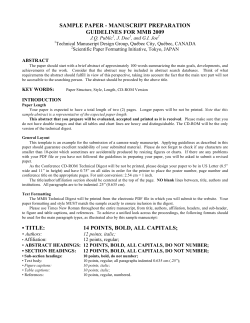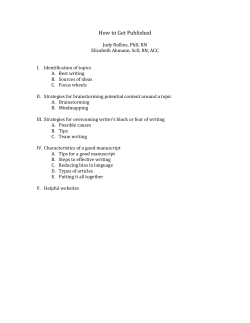
How to Prepare a Good Scientific Manuscript - Some Thoughts Kai Sundmacher
How to Prepare a Good Scientific Manuscript - Some Thoughts Kai Sundmacher1,2 1 Max Planck Institute for Dynamics of Complex Technical Systems, Department of Process Systems Engineering 2 Otto-von-Guericke University Magdeburg, Chair of Process Systems Engineering sundmacher@mpi-magdeburg.mpg.de DocDay, Magdeburg, 24 September 2012 Scientific Publishing Industry All scientific research articles Other Commercial University Presses Informa / Other Taylor & Francis Wiley-Blackwell Elsevier Springer Elsevier – by disciplines Environmental Science Earth Sciences Social Sciences Mathematics & Computer Science Physics Chemistry & Chemical Engineering Learned Societies 1.2 million English language research articles published globally each year Life Sciences Materials Science & Engineering 250,000+ English language research articles published with Elsevier every year Dr. Angela Welch, Elsevier (2012) 2 My Role in this Publishing Industry Publisher: Elsevier Publisher: Wiley-VCH Executive Editor of Chemical Engineering Science Review Editor of Fuel Cells Author (First, Senior, Co) of > 240 articles (WoS) Reviewer for peer-review journals (AIChE J, CES, CEJ, EA, IECR, JES, JMS, Science, ...) 3 1) What steps do I need to take before I write my paper ? 2) How can I ensure I am using proper manuscript language ? 3) How do I build up my article properly ? 4 Determine if you are ready to publish You should consider publishing if you have information that advances understanding in a specific research field. This could be in the form of: • Presenting new, original results or methods • Rationalizing, refining, or reinterpreting published results • Reviewing or summarizing a particular subject or field If you are ready to publish, a strong manuscript is what is needed next. 5 What is a strong manuscript? • Has a clear, useful, and exciting message. • Is presented and constructed in a logical manner. • Reviewers and editors can grasp the significance easily. Editors and reviewers are all busy people. Make things easy to save their time ! 6 Decide the most appropriate type of manuscript • • • • Conference papers Full articles / original articles Short communications / letters Review papers / perspectives Self-evaluate your work: Is it sufficient for a full article? Or are your results so thrilling that they need to be shown as soon as possible? Ask your supervisor and colleagues for advice on the manuscript type. Sometimes outsiders see things more clearly than you. 7 Types of manuscripts • Conference papers in-progress research findings (510 pages, ~ 3 figures) • Short communications early reports of significant, original advances • Original articles disseminating completed research findings (8-10 pages, 5-8 figures, ~ 25 references) • Review papers typically solicited by journal editors (10+ pages, 8+ figures, > 80 ref.) If patent is planned, wait with manuscript submission until patent application is documented! 8 Journal Selection TIP: Articles in your references will likely lead you to the right journal. Visit the journal homepages: Aims and scope (see: guide for authors) Accepted types of articles Readership Current hot topics (go through the abstracts of recent publications) DO NOT gamble by submitting your manuscript to more than one journal at a time. International ethics standards prohibit multiple submissions ! 9 1) What steps do I need to take before I write my paper ? 2) How can I ensure I am using proper manuscript language ? 3) How do I build up my article properly ? 10 Manuscript Language Write with clarity, objectivity, accuracy, and brevity ! The key to successful manuscript writing is to be alert to common errors: Sentence construction Incorrect tenses Inaccurate grammar Mixing languages Publishers do not correct the language. It is the author’s responsibility to make sure his paper is in its best possible form when submitted for publication. But: Publishers often provide resources for authors who are less familiar with the conventions of international journals. 11 Manuscript Language Proper manuscript language is important so that editors and reviewers can easily understand your messages. Refer to the journal’s Guide for Authors for specifications. Check that your paper has short sentences, correct tenses, correct grammar, and is all in English. Have a native English speaker check your manuscript or use a language editing service. 12 1) What steps do I need to take before I write my paper ? 2) How can I ensure I am using proper manuscript language ? 3) How do I build up my article properly ? 13 Research Article Structure • Title • Abstract • Keywords • Main text (IMRAD) – Introduction – Methods – Results – And – Discussions • • • • Conclusions Acknowledgements References Supplementary Data Make them easy for indexing and searching! (informative, attractive, effective) How do you search for a paper? Make sure each section of the paper fulfills its purpose clearly and concisely. Write in the same order you read: 1) Figures and tables 2) Methods, Results and Discussion 3) Conclusions and Introduction 4) Abstract and Title 14 Article Title A good title should contain the fewest possible words that adequately describe the content of a paper. Effective titles: - identify the main issue of the paper - begin with the subject of the paper - are accurate, unambiguous, specific, and complete - are as short as possible - do not contain rarely-used abbreviations 15 Article Title Original Title Revised Remarks Preliminary observations on the effect of Zn element on anticorrosion of zinc plating layer Effect of Zn on anticorrosion of zinc plating layer Long title distracts readers. Remove all redundancies such as “observations on”, “the nature of”, etc. Action of antibiotics on bacteria Inhibition of growth of mycobacterium tuberculosis by streptomycin Titles should be specific. Think to yourself: “How will I search for this piece of information?” when you design the title. Fabrication of carbon/CdS coaxial nanofibers displaying optical and electrical properties via electrospinning carbon Electrospinning of carbon/CdS coaxial nanofibers with optical and electrical properties “English needs help. The title is nonsense. All materials have properties of all varieties. You could examine my hair for its electrical and optical properties! You MUST be specific. I haven’t read the paper but I suspect there is something special about these properties, otherwise why would you be reporting them?” – the Editor-in-chief 16 Abstract It is freely freely available in electronic abstracting & indexing services [PubMed, Medline, Embase, SciVerse Scopus, ....] This is the advertisement of your article. Make it interesting, and easy to be understood without reading the whole article. What has been done? What are the main findings? Follow the Rule of 10: - 2 sentences: introduction / aim - 3 sentences: materials & methods - 3 sentences: results - 2 sentences: discussion/conclusions 17 Keywords Keywords are used by indexing and abstracting services. They are the labels of your manuscript. Use only established abbreviations (e.g. DNA). Check the “Guide for Authors”. Example: Article Title Keywords “Silo music and silo quake: granular flow-induced vibration” Silo music, Silo quake, stick-slip flow, resonance, creep, granular discharge “An experimental study on evacuated tube solar collector using supercritical CO2” Solar collector; Supercritical CO2; Solar energy; Solar thermal utilization 18 Introduction Clearly address the following: – What is the problem ? – Are there any existing solutions ? – Which is the best solution so far? – What is its main limitation? – What do you hope to achieve? – How will you fill the gap? TIP: Hypothesis/aim of the study is typically found in the last paragraph of the introduction. 19 Methods Include detailed information. The reader should be able to reproduce the experiment / the simulation. Previously published procedures need not be described in depth: - Cite methods and note any changes to the protocol - Provide detailed methods in Supplemental Material Identify the equipment and materials used - Provide source and related product information (company, molecular weight, etc.) Write out full chemical/biological compound names (followed by abbr.), then use abbreviations throughout paper. 20 Results Tell a clear and easy-to-understand story: - The main findings • Analytical description of data from experiments described in the Methods section. • Findings/data of secondary importance should be captured in Supplementary Materials • Minimal interpretation of results and/or comparison with literature unless the journal combines the Results & Discussion sections - If applicable: Results of statistical analysis - Figures and tables 21 Results: Figures & Tables Illustrations are critical because - Figures and tables are the most efficient way to present results and - Results are the driving force of the publication Captions and legends should be self-explanatory; figures should be able to stand alone - What is the take home point? Maximize space; make sure final versions of figures can be easily read (watch use of legends) Use consistent formatting between figures - Plots: labels and scale - Micrographs: scale bar, point out key features 22 Discussion Most important section Critical interpretation - Make the discussion correspond to the results - Compare your results to published results Significance & implications - How does your data relate to the “big picture” / applications? - Can you identify a mechanism or form new hypotheses? 23 Conclusions How your work advances the field from the present state of knowledge Justify your work in the research field - Uses ? - Extensions ? - Applications ? Suggest future experiments and/or theoretical investigations 24 References Conform strictly to the journal citation style specified in the Guide for Authors Editors may use plagiarism detection software to validate authenticity; give credit to original articles Avoid excessive self-citations 25 Submission: Cover Letter Your chance to speak to the editor directly ! Submitted along with your manuscript State final approval of all co-authors State prior reviews, revisions, etc. Mention what would make your manuscript special to the journal Nominate possible referees: experts, not collaborators, not best friends, not from your institution 26 Revision(s) Prepare a detailed Response Letter: – Copy-paste each reviewer comment and type your response below it. – State specifically which changes you made to the manuscript (include page/line numbers; be specific – no generalized statements like “the discussion was changed accordingly”). – Provide response to accept the reviewers’ suggestions or a convincing, solid, and polite rebuttal when you feel the reviewer was wrong. – Write in such a manner, that your response can be forwarded to the reviewer without prior editing. Revisions improve the quality of your article ! 27 I which you great success when preparing your articles! Questions ? Kai Sundmacher Docday@OvGUMagdeburg 24 September 2012 28
© Copyright 2025





















